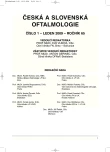Cataract Surgery without Preoperative Mydriasis
Authors:
K. Marešová 1; J. Procházková 2
Authors‘ workplace:
Oční klinika LF UP a FN, Olomouc, přednosta doc. MUDr. Jiří Řehák, CSc.
1; Oční centrum Palánek, Vyškov
2
Published in:
Čes. a slov. Oftal., 65, 2009, No. 1, p. 16-18
Overview
Preoperative mydriasis is usually obtained by means of using combinations of sympatomimetics and parasympatolytics. The disadvantages of this method are: longer preoperative preparing time, toxic effect of eye drops and adverse systemic effects in some patients. The alternative to the standard dilating drops is use of intracameral lidocaine during the surgery.
In our study, we used intracameral lidocaine 1% to achieve the mydriasis during the cataract surgery. By using this method, we operated on 38 eyes of 33 patients, 12 men and 21 women. The age ranged between 54 years and 85 years (mean, 72.2 years). The mean pupil diameter before dilation was 3.04 ± 0.62 mm. The time necessary to dilate the pupil was 8.82 ±2.54 sec and the mean pupil diameter after the dilation was 7.11 ± 0.74 mm. The pupil enlarged even more after the instillation of the ophthalmic viscoelastic material. At the end of the surgery, the diameter of the pupil was 7.12 ± 0.62 mm.
The mydriatic effect of intracameral lidocaine application is adequate and longstanding enough. This surgical method is wholly safe.
Key words:
cataract surgery, mydriasis, lidocaine
Sources
1. Intracameral mydriatic delivery: simplifying the proces. Ophthalmology Times Europe, October 2007, 21.
2. Cionni, J.R., Barros, G.M., Kaufman, A.H. et al.: Cataract surgery without preoperative eyedrops. J Cataract Refract Surg, 29, 2003, 12: 2281–2283.
3. Corneal endotelial toxicity of different lidocaine concentrations. J Cataract et Refract Surg, 26, 2000, 9: 1403-1408.
4. Fraunfelder, F.W., Fraunfelder, F.T., Jensvold, B.: Adverse systemic effects from pledgets of topical ocular phenylephrine 10%. Am J Ophthalmol, 134, 2002, 4: 624–625.
5. Lincoff, H., Zweifach, P., Brodie, S. et al.: Intraocular injection of lidocaine. Ophthalmology, 92, 1985: 1587–1591.
6. Lundberg, B., Behndig, A.: Intracameral mydriatics in phacoemulsification cataract surgery. J Cataract Refract Surg, 29, 2003, 12: 2366–2371.
7. Lundberg, B., Behndig, A.: Separate and additive mydriatic effect of lidocaine hydrochloride, phenylephrine, and cyclopentolate after intracameral injection. J Cataract Refract Surg, 34, 2008, 2:280–283.
8. Scawn, R., Ward, M., Packard, R.: Intracameral phenylephrine. Safety and efficacy as preoperative mydriatic in routine cataract surgery, 257. In: Book of abstracts XXV. Congress of the ESCRS Stockholm 2007.
9. Ozkurt, Y.: Intraoperative lidocain in phacoemulsification without preoperative eyedrops. J Cataract Refract Surg, 32, 2006, 1: 178.
Labels
OphthalmologyArticle was published in
Czech and Slovak Ophthalmology

2009 Issue 1
Most read in this issue
- Central Corneal Thickness, Intraocular Pressure and Their Correlation in Healthy Czech Children Aged 7–17 Years
- Selective Laser Trabeculoplasty – New Possibilities in Glaucoma Treatment
- The Follow up of Prognostic Important Factors and Analysis of Five Years Survival Rate in Patients with Uveal Melanoma at the Department of Ophthalmology, 3rd Medical Faculty, Charles University in Prague and the Faculty Hospital Královské Vinohrady in Prague
- Cataract Surgery without Preoperative Mydriasis
